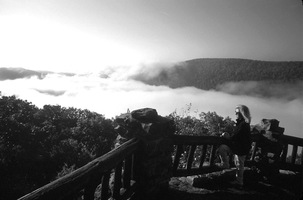 | Back to e-WV
| Back to e-WV
 The West Virginia Encyclopedia
The West Virginia Encyclopedia
 | Back to e-WV
| Back to e-WV
 The West Virginia Encyclopedia
The West Virginia Encyclopedia

Coopers Rock State Forest is located 13 miles east of Morgantown on the Monongalia-Preston county line. The forest is named for Coopers Rock, a series of cliffs capping the mountain above Cheat River Gorge. These landmark cliffs are formed of hard sandstone of the Pottsville series, overlying softer sandstone below. The forest has 12,747 acres, used for recreation, timber management, and watershed and wildlife protection. Forest land on the north side of Interstate 68, known as the West Virginia University Forest, is leased by WVU for forestry research, teaching, and demonstration. The recreational area south of I-68 includes camping sites, a concession stand, and the spectacular main overlook which offers a panoramic view of the gorge and surrounding mountains.
The state forest was established in 1936. During the Great Depression, the Civilian Conservation Corps made numerous improvements, building the overlook with its stone steps, the rustic picnic shelters, and other structures. In 1991, the superintendent’s house and garage were added to the National Register of Historic Places.
In 1996, Governor Gaston Caperton capped a seven-year campaign by local and national preservation groups to bring 2,000 more acres into the forest. The view on the ‘‘other side’’ of the mile-wide gorge was thus protected from development. Trails around the top of the gorge and extending into the forest offer hikers excellent views of blossoming rhododendron and mountain laurel in June and fall foliage in autumn. Wildlife is abundant and includes wilderness birds such as ravens, as well as hawks, owls, and songbirds. Foxes, chipmunks, and squirrels can be seen throughout the forest. No-hunting zones surround recreational facilities. One of the earliest enterprises along the Cheat River was the smelting and forging of iron, which was produced at what is now Coopers Rock. The impressive Henry Clay Furnace, a cold blast iron furnace, was built about 1836 and still stands as a monument to the early iron industry. It was fired by charcoal, produced from the abundance of nearby forest trees. Remains of charcoal pits can still be seen in the forest.
Read the National Register of Historic Places nomination.
Written by Norma Jean Kennedy-Venable
Core, Earl L. The Monongalia Story 5 vols. Parsons: McClain, 1974-84.
Rodd, Judith. A Guide to Coopers Rock State Forest. Moatsville: Barn Echo Press, 1994.
Carvell, Kenneth L. Heartstone of Coopers Rock State Forest. Wonderful West Virginia, (Mar. 1975).